Requirement on the Capacity of Energy Storage to Meet the 2 °C Goal
Abstract
1. Introduction
2. Materials and Methods
2.1. The Compact Earth System Model
2.2. Hourly Power Supply by Wind and Photovoltaics
2.3. Capacity of Power Supply and Negative Emissions by BECCS
2.4. Capacity of Energy Storage for Wind, PV, and BECCS
2.5. Consumption of Minerals in Batteries for Energy Storage
3. Results and Discussion
3.1. Impacts of Deploying Energy Storage on Global Warming
3.2. Dependence of the Effects of Mitigation on Energy Storage
3.3. Spatial Distribution of Wind, PV, and Bioenergy Production
3.4. Global Demand for the Capacity of Energy Storage Using Batteries
3.5. Limitation to Energy Storage by Mineral Reserves
4. Conclusions
Supplementary Materials
Author Contributions
Funding
Institutional Review Board Statement
Informed Consent Statement
Data Availability Statement
Conflicts of Interest
References
- Intergovernmental Panel on Climate Change (IPCC). In Climate Change 2021: The Physical Science Basis. Contribution of Working Group I to the Sixth Assessment Report of the Intergovernmental Panel on Climate Change. 2021. Available online: https://www.ipcc.ch/assessment-report/ar6/ (accessed on 21 April 2022).
- United Nations Framework Convention on Climate Change (UNFCCC). Paris Agreement—Status of Ratification. 2021. Available online: https://unfccc.int/process/the-paris-agreement/status-of-ratification (accessed on 4 April 2022).
- Dai, H.J. Roles of Surface Albedo, Surface Temperature and Carbon Dioxide in the Seasonal Variation of Arctic Amplification. Geophys. Res. Lett. 2021, 48, e2020GL090301. [Google Scholar] [CrossRef]
- De la Peña, L.; Guo, R.; Cao, X.J.; Ni, X.J.; Zhang, W. Accelerating the energy transition to achieve carbon neutrality. Resour. Conserv. Recycl. 2022, 177, 105957. [Google Scholar] [CrossRef]
- Ma, Q.; Tariq, M.; Mahmood, H.; Khan, Z. The nexus between digital economy and carbon dioxide emissions in China: The moderating role of investments in research and development. Technol. Soc. 2022, 68, 101910. [Google Scholar] [CrossRef]
- Arent, D.J.; Green, P.; Abdullah, Z.; Barnes, T.; Bauer, S.; Bernstein, A.; Berry, D.; Berry, J.; Burrell, T.; Carpenter, B.; et al. Challenges and opportunities in decarbonizing the US energy system. Renew. Sust. Energ. Rev. 2022, 169, 112939. [Google Scholar] [CrossRef]
- Nakicenovic, N.; Lund, P.D. Could Europe become the first climate-neutral continent? Nature 2021, 596, 486. [Google Scholar] [CrossRef]
- Kim, J.K.; Park, H.; Kim, S.J.; Lee, J.; Song, Y.; Yi, S.C. Optimization models for the cost-effective design and operation of renewable-integrated energy systems. Renew. Sust. Energ. Rev. 2023, 183, 113429. [Google Scholar] [CrossRef]
- Azarinfar, H.; Khosravi, M.; Sabzevari, K.; Dzikuc, M. Stochastic Economic-Resilience Management of Combined Cooling, Heat, and Power-Based Microgrids in a Multi-Objective Approach. Sustainability 2024, 16, 1212. [Google Scholar] [CrossRef]
- Intergovernmental Panel on Climate Change (IPCC). In Climate Change 2022: Mitigation of Climate Change. Working Group III Contribution to the IPCC Sixth Assessment Report. 2022. Available online: https://www.ipcc.ch/report/sixth-assessment-report-working-group-3/ (accessed on 25 April 2024).
- Ma, Y.H.; Xie, K.G.; Zhao, Y.A.; Yang, H.J.; Zhang, D.B. Bi-objective Layout Optimization for Multiple Wind Farms Considering Sequential Fluctuation of Wind Power Using Uniform Design. CSEE J. Power Energy Syst. 2022, 8, 1623–1635. [Google Scholar] [CrossRef]
- Xia, W.Y.; Ren, Z.Y.; Li, H.; Hu, B. A power fluctuation evaluation method of PV plants based on RankBoost ranking. Prot. Control Mod. Power Syst. 2021, 6, 27. [Google Scholar] [CrossRef]
- Poblete, I.B.S.; Araujo, O.D.F.; de Medeiros, J.L. Dynamic analysis of sustainable biogas-combined-cycle plant: Time-varying demand and bioenergy with carbon capture and storage. Renew. Sust. Energ. Rev. 2020, 131, 109997. [Google Scholar] [CrossRef]
- Yang, M.; Wang, D.; Xu, C.Y.; Dai, B.Z.; Ma, M.M.; Su, X. Power transfer characteristics in fluctuation partition algorithm for wind speed and its application to wind power forecasting. Renew. Energy 2023, 211, 582–594. [Google Scholar] [CrossRef]
- Chen, S.; Lu, X.; Miao, Y.F.; Deng, Y.; Nielsen, C.P.; Elbot, N.; Wang, Y.C.; Logan, K.G.; McElroy, M.B.; Hao, J.M. The Potential of Photovoltaics to Power the Belt and Road Initiative. Joule 2019, 3, 1895–1912. [Google Scholar] [CrossRef]
- Waha, K.; Dietrich, J.P.; Portmann, F.T.; Siebert, S.; Thornton, P.K.; Bondeau, A.; Herrero, M. Multiple cropping systems of the world and the potential for increasing cropping intensity. Glob. Environ. Chang.-Hum. Policy Dimens. 2020, 64, 102131. [Google Scholar] [CrossRef] [PubMed]
- Li, J.D.; Chen, S.J.; Wu, Y.Q.; Wang, Q.H.; Liu, X.; Qi, L.J.; Lu, X.Y.; Gao, L. How to make better use of intermittent and variable energy? A review of wind and photovoltaic power consumption in China. Renew. Sust. Energ. Rev. 2021, 137, 110626. [Google Scholar] [CrossRef]
- Jafari, M.; Botterud, A.; Sakti, A. Decarbonizing power systems: A critical review of the role of energy storage. Renew. Sust. Energ. Rev. 2022, 158, 112077. [Google Scholar] [CrossRef]
- Peng, W.; Sadaghiani, O.K. An Analytical Review on the Utilization of Machine Learning in the Biomass Raw Materials, Their Evaluation, Storage, and Transportation. Arch. Comput. Method Eng. 2023, 30, 4711–4732. [Google Scholar] [CrossRef]
- Li, Q.; Li, Z.; Zhang, Z.; Tao, Y.; Bian, R. Energy storage capacity optimization strategy for combined wind storage system. Energy Rep. 2022, 8, 247–252. [Google Scholar] [CrossRef]
- Tejero-Gómez, J.A.; Bayod-Rujula, A.A. Analysis of Photovoltaic Plants with Battery Energy Storage Systems (PV-BESS) for Monthly Constant Power Operation. Energies 2023, 16, 4909. [Google Scholar] [CrossRef]
- Gasser, T.; Crepin, L.; Quilcaille, Y.; Houghton, R.A.; Ciais, P.; Obersteiner, M. Historical CO2 emissions from land use and land cover change and their uncertainty. Biogeosciences 2020, 17, 4075–4101. [Google Scholar] [CrossRef]
- Gasser, T.; Kechiar, M.; Ciais, P.; Burke, E.J.; Kleinen, T.; Zhu, D.; Huang, Y.; Ekici, A.; Obersteiner, M. Path-dependent reductions in CO2 emission budgets caused by permafrost carbon release. Nat. Geosci. 2018, 11, 830–835. [Google Scholar] [CrossRef]
- Quilcaille, Y.; Gasser, T.; Ciais, P.; Boucher, O. CMIP6 simulations with the compact Earth system model OSCAR v3.1. Geosci. Model Dev. 2023, 16, 1129–1161. [Google Scholar] [CrossRef]
- Gelaro, R.; McCarty, W.; Suárez, M.J.; Todling, R.; Molod, A.; Takacs, L.; Randles, C.A.; Darmenov, A.; Bosilovich, M.G.; Reichle, R.; et al. The Modern-Era Retrospective Analysis for Research and Applications, Version 2 (MERRA-2). J. Clim. 2017, 30, 5419–5454. [Google Scholar] [CrossRef]
- Global Modeling and Assimilation Office (GMAO). GEOS Atmospheric Assimilation Products. 2021. Available online: https://gmao.gsfc.nasa.gov/GMAO_products/NRT_products.php (accessed on 2 September 2022).
- Food and Agriculture Organization of the United Nations (FAO). FAOSTAT. 2019. Available online: https://www.fao.org/faostat/en/#data (accessed on 30 June 2021).
- U.S. Department of Agriculture Foreign Agricultural Service (FAS). Country Summary. 2023. Available online: https://ipad.fas.usda.gov/countrysummary/?id=US (accessed on 20 May 2023).
- Bauer, N.; Calvin, K.; Emmerling, J.; Fricko, O.; Fujimori, S.; Hilaire, J.; Eom, J.; Krey, V.; Kriegler, E.; Mouratiadou, I.; et al. Shared Socio-Economic Pathways of the Energy Sector—Quantifying the Narratives. Glob. Environ. Chang.-Hum. Policy Dimens. 2017, 42, 316–330. [Google Scholar] [CrossRef]
- International Institute for Applied Systems Analysis (IIASA). SSP Database (Shared Socioeconomic Pathways)—Version 2.0. 2018. Available online: https://tntcat.iiasa.ac.at/SspDb/dsd?Action=htmlpage&page=welcome (accessed on 15 January 2022).
- Gasser, T.; Ciais, P.; Boucher, O.; Quilcaille, Y.; Tortora, M.; Bopp, L.; Hauglustaine, D. The compact Earth system model OSCAR v2.2: Description and first results. Geosci. Model Dev. 2017, 10, 271–319. [Google Scholar] [CrossRef]
- Xu, S.Q.; Wang, R.; Gasser, T.; Ciais, P.; Penuelas, J.; Balkanski, Y.; Boucher, O.; Janssens, I.A.; Sardans, J.; Clark, J.H.; et al. Delayed use of bioenergy crops might threaten climate and food security. Nature 2022, 609, 299–306. [Google Scholar] [CrossRef]
- Ghugare, S.B.; Tambe, S.S. Genetic programming based high performing correlations for prediction of higher heating value of coals of different ranks and from diverse geographies. J. Energy Inst. 2017, 90, 476–484. [Google Scholar] [CrossRef]
- Schakel, W.; Meerman, H.; Talaei, A.; Ramírez, A.; Faaij, A. Comparative life cycle assessment of biomass co-firing plants with carbon capture and storage. Appl. Energy 2014, 131, 441–467. [Google Scholar] [CrossRef]
- Wang, Y.; Wang, R.; Tanaka, K.; Ciais, P.; Penuelas, J.; Balkanski, Y.; Sardans, J.; Hauglustaine, D.; Liu, W.; Xing, X.; et al. Accelerating the energy transition towards photovoltaic and wind in China. Nature 2023, 619, 761–767. [Google Scholar] [CrossRef]
- U.S. Geological-Survey (USGS). Land Cover Type Yearly L3 Global 500 m SIN Grid. 2014. Available online: https://lpdaac.usgs.gov/products/mcd12q1v006/ (accessed on 12 December 2021).
- U.S. Geological-Survey (USGS). Shuttle Radar Topography Mission (SRTM). 2015. Available online: https://earthexplorer.usgs.gov/ (accessed on 13 December 2021).
- Amatulli, G.; Domisch, S.; Tuanmu, M.N.; Parmentier, B.; Ranipeta, A.; Malczyk, J.; Jetz, W. A suite of global, cross-scale topographic variables for environmental and biodiversity modeling. Sci. Data 2018, 5, 1–15. [Google Scholar] [CrossRef]
- Resource and Environment Science and Data Center. Environmental Protection Areas. 2020. Available online: https://www.resdc.cn/data.aspx?DATAID=137 (accessed on 11 December 2021).
- Kumar, A.; Cameron, J.B.; Flynn, P.C. Biomass power cost and optimum plant size in western Canada. Biomass Bioenerg. 2003, 24, 445–464. [Google Scholar] [CrossRef]
- Friedlingstein, P.; O’Sullivan, M.; Jones, M.W.; Andrew, R.M.; Hauck, J.; Olsen, A.; Peters, G.P.; Peters, W.; Pongratz, J.; Sitch, S.; et al. Global Carbon Budget 2020. Earth Syst. Sci. Data 2020, 12, 3269–3340. [Google Scholar] [CrossRef]
- Harvard Dataverse. PLEXOS-World. 2020. Available online: https://dataverse.harvard.edu/dataverse/PLEXOS-World (accessed on 21 February 2023).
- Watil, A.; El Magri, A.; Lajouad, R.; Raihani, A.; Giri, F. Multi-mode control strategy for a stand-alone wind energy conversion system with battery energy storage. J. Energy Storage 2022, 51, 104481. [Google Scholar] [CrossRef]
- Zhu, Z.X.; Jiang, T.L.; Ali, M.; Meng, Y.H.; Jin, Y.; Cui, Y.; Chen, W. Rechargeable Batteries for Grid Scale Energy Storage. Chem. Rev. 2022, 122, 16610–16751. [Google Scholar] [CrossRef]
- International Energy Agency (IEA). Net Zero by 2050. 2021. Available online: https://www.iea.org/reports/net-zero-by-2050 (accessed on 11 December 2022).
- Energy Storage Application Branch of China Industrial Association of Power Sources (CESA). 2022 Energy Storage Industry Application Research Report. 2022. Available online: https://www.ciaps.org.cn/ (accessed on 4 February 2023).
- Sha, W.X.; Guo, Y.Q.; Cheng, D.P.; Han, Q.G.; Lou, P.; Guan, M.Y.; Tang, S.; Zhang, X.F.; Lu, S.F.; Cheng, S.J.; et al. Degradation mechanism analysis of LiNi0.5Co0.2Mn0.3O2 single crystal cathode materials through machine learning. NPJ Comput. Mater. 2022, 8, 223. [Google Scholar] [CrossRef]
- Xu, C.J.; Dai, Q.; Gaines, L.; Hu, M.M.; Tukker, A.; Steubing, B. Future material demand for automotive lithium-based batteries. Commun. Mater. 2020, 1, 99. [Google Scholar] [CrossRef]
- International Energy Agency (IEA). Global Supply Chains of EV Batteries 2022. Available online: https://www.iea.org/reports/global-supply-chains-of-ev-batteries (accessed on 5 February 2023).
- Fan, X.M.; Hu, G.R.; Zhang, B.; Ou, X.; Zhang, J.F.; Zhao, W.G.; Jia, H.P.; Zou, L.F.; Li, P.; Yang, Y. Crack-free single-crystalline Ni-rich layered NCM cathode enable superior cycling performance of lithium-ion batteries. Nano Energy 2020, 70, 104450. [Google Scholar] [CrossRef]
- Li, W.D.; Liu, X.M.; Celio, H.; Smith, P.; Dolocan, A.; Chi, M.F.; Manthiram, A. Mn versus Al in Layered Oxide Cathodes in Lithium-Ion Batteries: A Comprehensive Evaluation on Long-Term Cyclability. Adv. Energy Mater. 2018, 8, 1703154. [Google Scholar] [CrossRef]
- Liu, S.; Xiong, L.; He, C. Long cycle life lithium ion battery with lithium nickel cobalt manganese oxide (NCM) cathode. J. Power Sources 2014, 261, 285–291. [Google Scholar] [CrossRef]
- U.S. Geological-Survey (USGS). Commodity Statistics and Information by National Minerals Information Center. 2022. Available online: https://www.usgs.gov/centers/national-minerals-information-center/commodity-statistics-and-information (accessed on 7 December 2021).
- O’Neill, B.C.; Kriegler, E.; Ebi, K.L.; Kemp-Benedict, E.; Riahi, K.; Rothman, D.S.; van Ruijven, B.J.; van Vuuren, D.P.; Birkmann, J.; Kok, K.; et al. The roads ahead: Narratives for shared socioeconomic pathways describing world futures in the 21st century. Glob. Environ. Chang.-Hum. Policy Dimens. 2017, 42, 169–180. [Google Scholar] [CrossRef]
- Cherp, A.; Vinichenko, V.; Tosun, J.; Gordon, J.A.; Jewell, J. National growth dynamics of wind and solar power compared to the growth required for global climate targets. Nat. Energy 2021, 6, 742–754. [Google Scholar] [CrossRef]
- Hu, Q.; Xiang, M.T.; Chen, D.; Zhou, J.; Wu, W.B.; Song, Q. Global cropland intensification surpassed expansion between 2000 and 2010: A spatio-temporal analysis based on GlobeLand30. Sci. Total Environ. 2020, 746, 141035. [Google Scholar] [CrossRef]
- Mearns, E.; Sornette, D. Are 2050 energy transition plans viable? A detailed analysis of projected Swiss electricity supply and demand in 2050. Energy Policy 2023, 175, 113347. [Google Scholar] [CrossRef]
- Abbassi, A.; Dami, M.A.; Jemli, M. A statistical approach for hybrid energy storage system sizing based on capacity distributions in an autonomous PV/Wind power generation system. Renew. Energy 2017, 103, 81–93. [Google Scholar] [CrossRef]
- Amir, M.; Deshmukh, R.G.; Khalid, H.M.; Said, Z.; Raza, A.; Muyeen, S.; Nizami, A.-S.; Elavarasan, R.M.; Saidur, R.; Sopian, K. Energy storage technologies: An integrated survey of developments, global economical/environmental effects, optimal scheduling model, and sustainable adaption policies. J. Energy Storage 2023, 72, 108694. [Google Scholar] [CrossRef]
- He, Y.; Guo, S.; Zhou, J.X.; Wu, F.; Huang, J.; Pei, H.J. The quantitative techno-economic comparisons and multi-objective capacity optimization of wind-photovoltaic hybrid power system considering different energy storage technologies. Energy Conv. Manag. 2021, 229, 113779. [Google Scholar] [CrossRef]
- International Energy Agency (IEA). Lithium-Ion Battery Manufacturing Capacity, 2022–2030. 2023. Available online: https://www.iea.org/data-and-statistics/charts/lithium-ion-battery-manufacturing-capacity-2022-2030 (accessed on 4 April 2023).
- S&P Global Market Intelligence. Top Electric Vehicle Markets Dominate Lithium-Ion Battery Capacity Growth. 2021. Available online: https://www.spglobal.com/marketintelligence/en/news-insights/blog/top-electric-vehicle-markets-dominate-lithium-ion-battery-capacity-growth (accessed on 20 April 2023).
- Jajja, M.S.S.; Hassan, S.Z.; Asif, M.; Searcy, C. Manufacturing value chain for battery electric vehicles in Pakistan: An assessment of capabilities and transition pathways. J. Clean Prod. 2021, 328, 129512. [Google Scholar] [CrossRef]
- Sun, X.; Liu, Z.W.; Zhao, F.Q.; Hao, H. Global Competition in the Lithium-Ion Battery Supply Chain: A Novel Perspective for Criticality Analysis. Environ. Sci. Technol. 2021, 55, 12180–12190. [Google Scholar] [CrossRef] [PubMed]
- Zeng, A.Q.; Chen, W.; Rasmussen, K.D.; Zhu, X.H.; Lundhaug, M.; Muller, D.B.; Tan, J.; Keiding, J.K.; Liu, L.T.; Dai, T.; et al. Battery technology and recycling alone will not save the electric mobility transition from future cobalt shortages. Nat. Commun. 2022, 13, 1341. [Google Scholar] [CrossRef]
- Peters, J.F.; Baumann, M.; Zimmermann, B.; Braun, J.; Weil, M. The environmental impact of Li-Ion batteries and the role of key parameters–A review. Renew. Sustain. Energy Rev. 2017, 67, 491–506. [Google Scholar] [CrossRef]
- Calderon, J.L.; Bazilian, M.; Sovacool, B.; Hund, K.; Jowitt, S.M.; Nguyen, T.P.; Månberger, A.; Kah, M.; Greene, S.; Galeazzi, C.; et al. Reviewing the material and metal security of low-carbon energy transitions. Renew. Sust. Energ. Rev. 2020, 124, 109789. [Google Scholar] [CrossRef]
- Althaf, S.; Babbitt, C.W. Disruption risks to material supply chains in the electronics sector. Resour. Conserv. Recycl. 2021, 167, 105248. [Google Scholar] [CrossRef]
- Gao, J.-Q.; Yu, Y.; Wang, D.-H.; Wang, W.; Wang, C.-H.; Dai, H.-Z.; Hao, X.-F.; Cen, K. Effects of lithium resource exploitation on surface water at Jiajika mine, China. Environ. Monit. Assess. 2021, 193, 1–16. [Google Scholar] [CrossRef] [PubMed]
- Parker, S.S.; Clifford, M.J.; Cohen, B.S. Potential impacts of proposed lithium extraction on biodiversity and conservation in the contiguous United States. Sci. Total Environ. 2024, 911, 168639. [Google Scholar] [CrossRef] [PubMed]
- Worlanyo, A.S.; Jiangfeng, L. Evaluating the environmental and economic impact of mining for post-mined land restoration and land-use: A review. J. Environ. Manag. 2021, 279, 111623. [Google Scholar] [CrossRef] [PubMed]
- Li, K.K.; Wang, Y.M.; Zhang, Y.C.; Wang, S.S.; Zou, X.Y. Multi-Risk Assessment of Mine Lithium Battery Fire Based on Quantitative Factor Characterization. Int. J. Environ. Res. Public Health 2023, 20, 456. [Google Scholar] [CrossRef]
- Shutaleva, A.; Nikonova, Z.; Savchenko, I.; Martyushev, N. Environmental education for sustainable development in Russia. Sustainability 2020, 12, 7742. [Google Scholar] [CrossRef]
- Tan, L.; Yang, Z.; Irfan, M.; Ding, C.J.; Hu, M.; Hu, J. Toward low-carbon sustainable development: Exploring the impact of digital economy development and industrial restructuring. Bus. Strategy Environ. 2024, 33, 2159–2172. [Google Scholar] [CrossRef]
- Fan, E.; Li, L.; Wang, Z.; Lin, J.; Huang, Y.; Yao, Y.; Chen, R.; Wu, F. Sustainable recycling technology for Li-ion batteries and beyond: Challenges and future prospects. Chem. Rev. 2020, 120, 7020–7063. [Google Scholar] [CrossRef]
- Orangi, S.; Strømman, A.H. A techno-economic model for benchmarking the production cost of lithium-ion battery cells. Batteries 2022, 8, 83. [Google Scholar] [CrossRef]
- COP28 Presidency Summary. Energy and Industry, Just Transition, Indigenous Peoples. 2023. Available online: https://www.cop28.com/ (accessed on 10 January 2024).
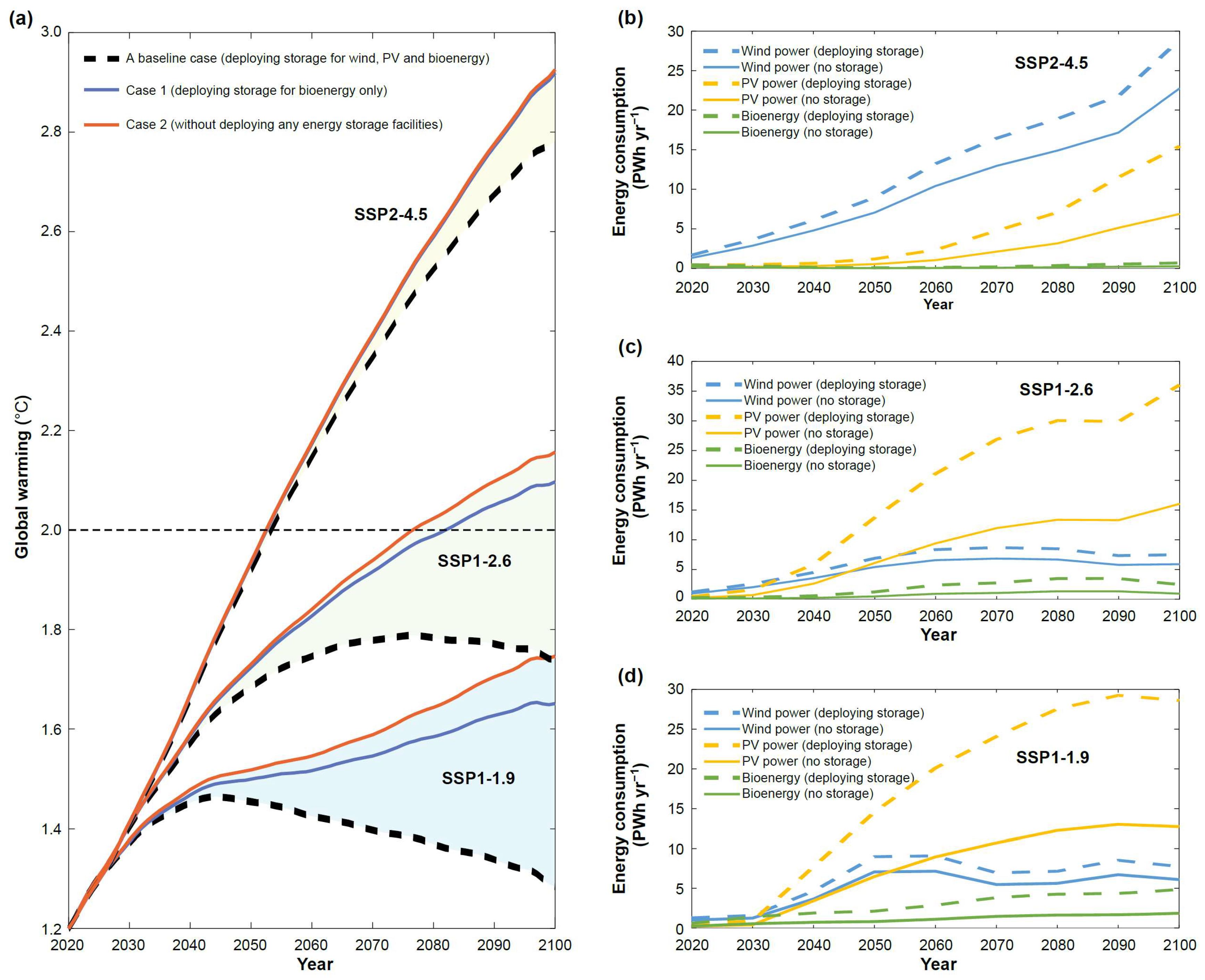
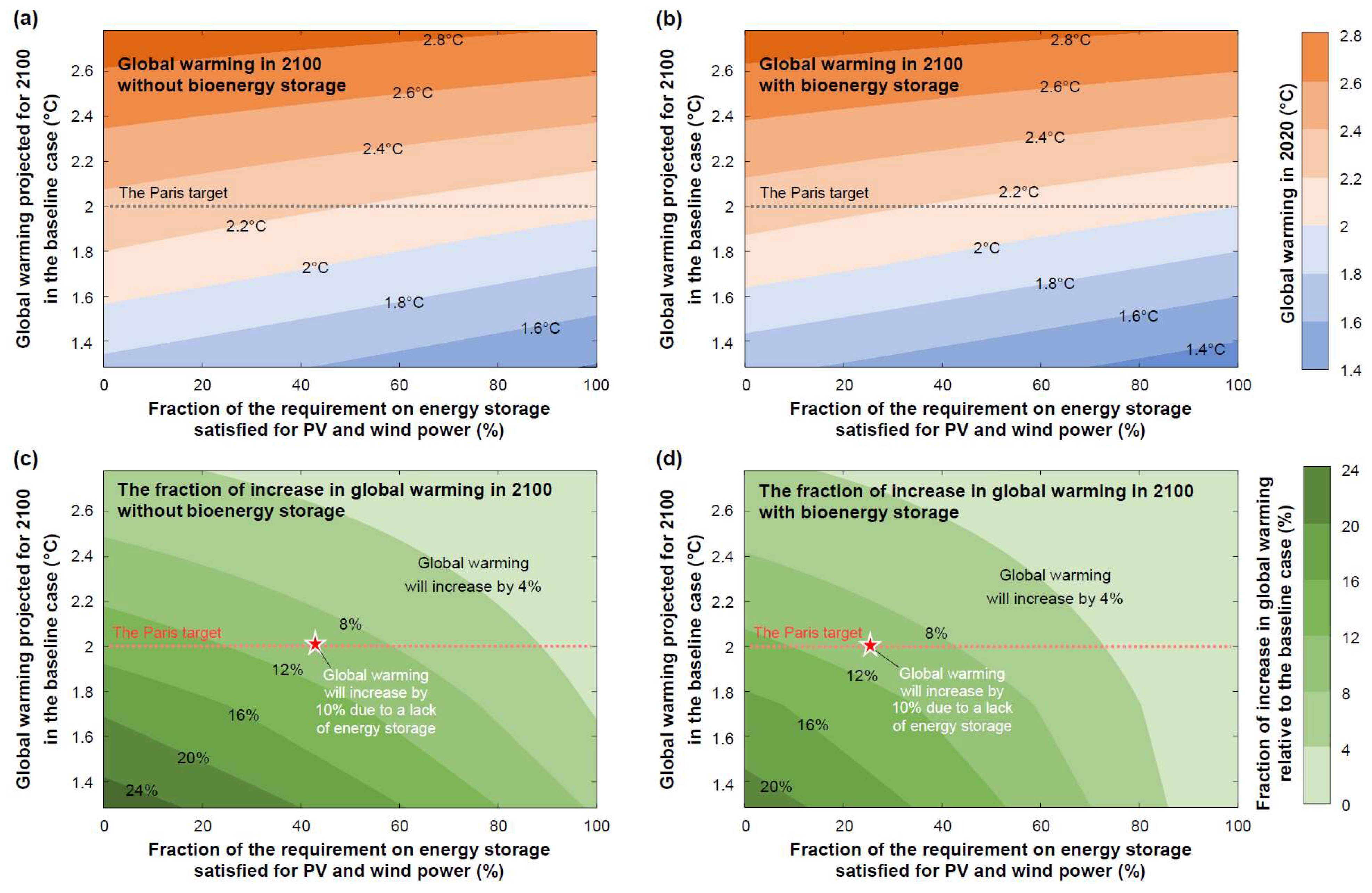
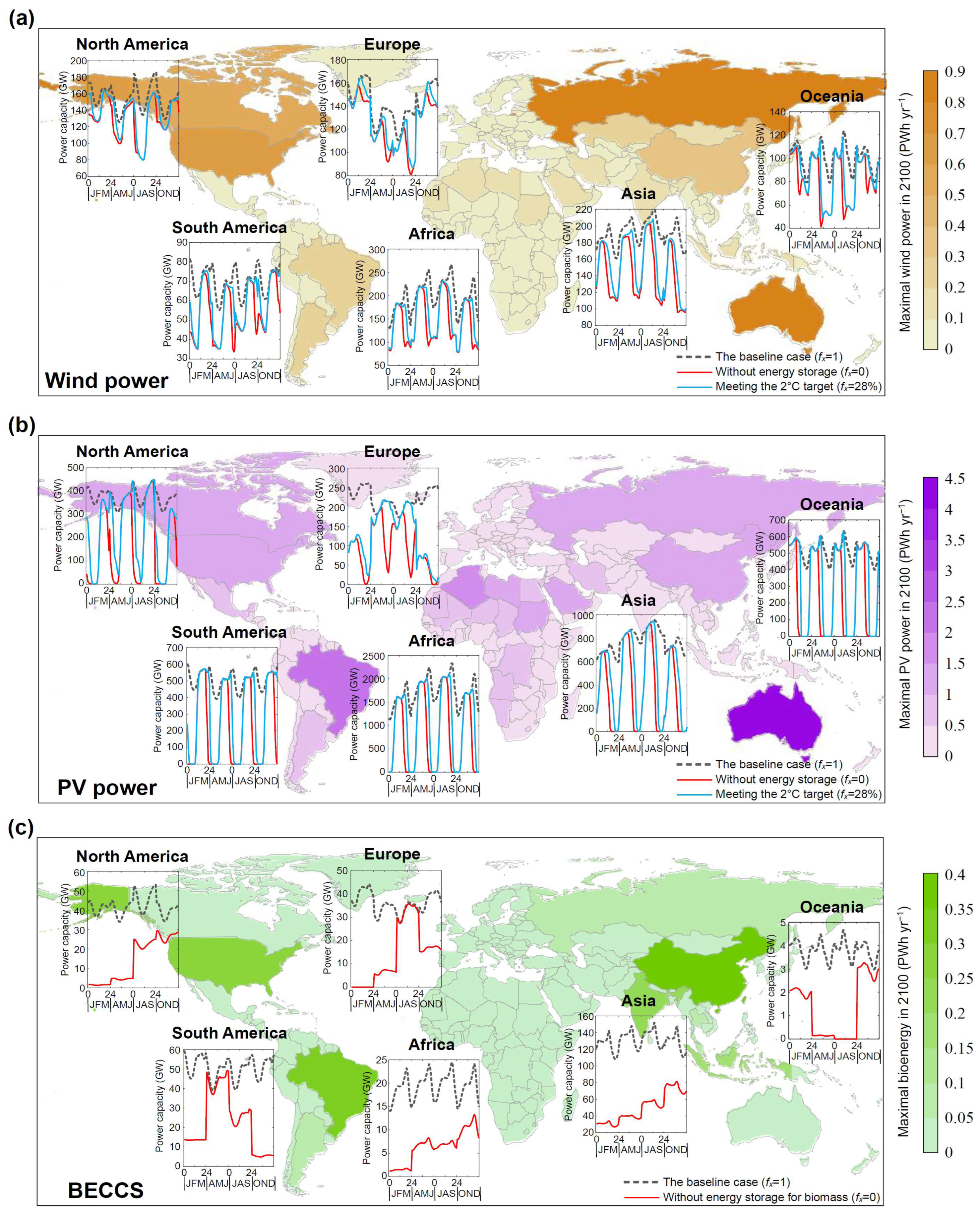
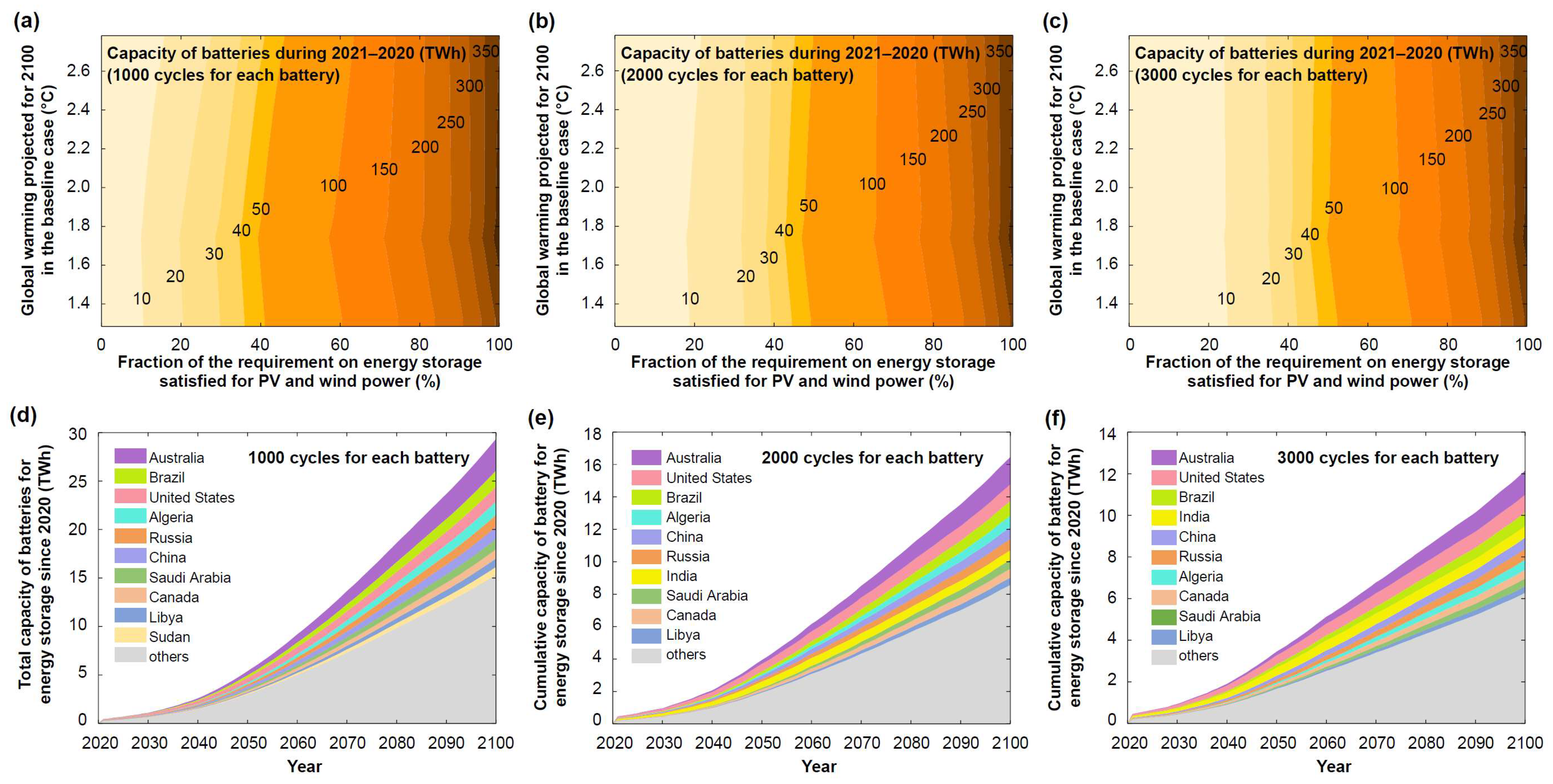
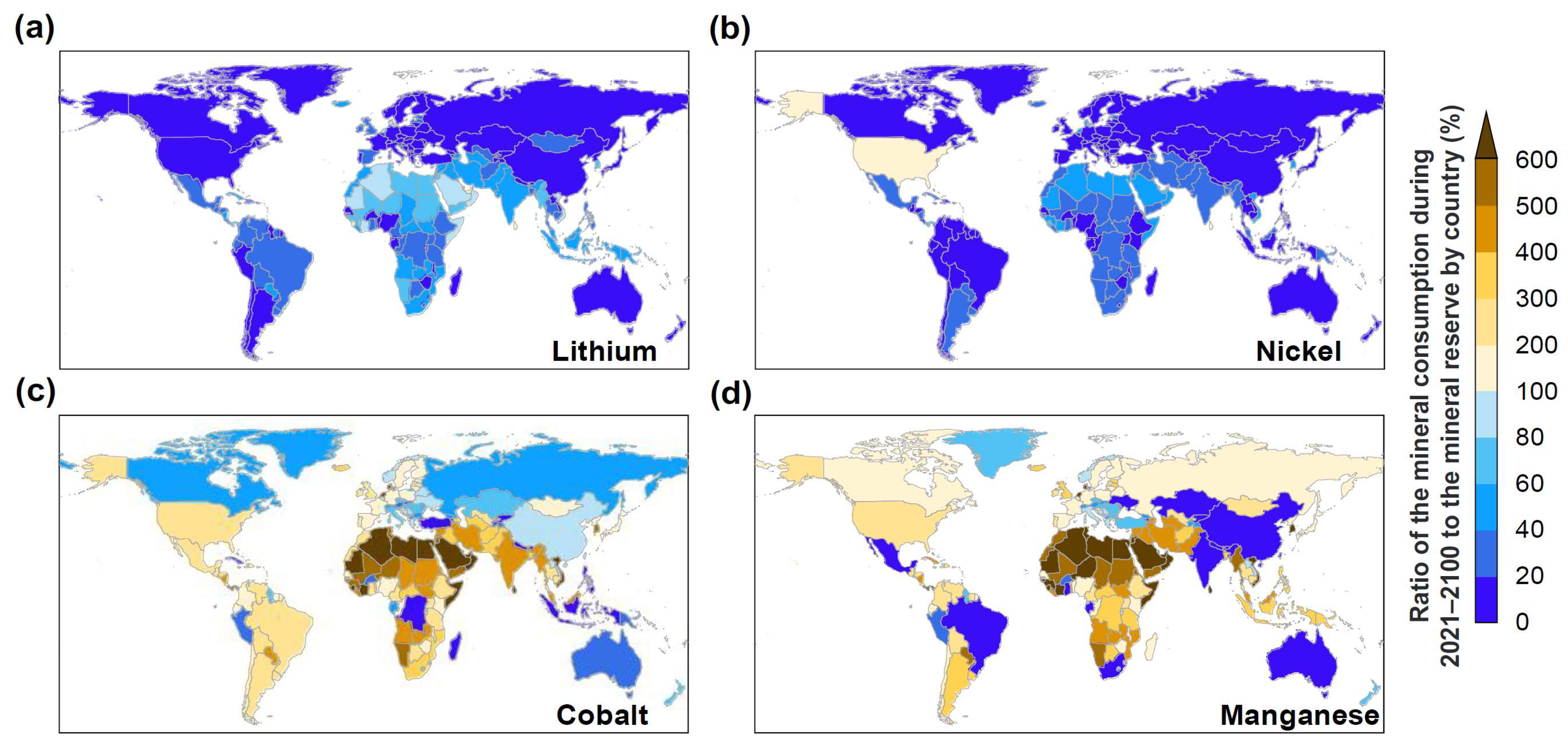
| Global Warming | Energy Storage by Batteries in 2021–2020 (TWh) | Power Generation in 2021–2100 (PWh yr−1) | Consumption of Minerals in 2021–2100 (Million Tons) | |||||||
|---|---|---|---|---|---|---|---|---|---|---|
| Wind | PV | Bioenergy | Fossil Fuel | Lithium | Nickel | Cobalt | Manganese | |||
| SSP 1-2.6 | 2.0 °C | 16.46 | 5.40 | 11.06 | 1.92 | 21.31 | 1.77 (0.7%) | 7.50 (1.7%) | 3.01 (51.3%) | 4.21 (49.6%) |
| 1.9 °C | 73.38 | 5.78 | 13.92 | 1.93 | 18.05 | 7.90 (39.0%) | 33.44 (23.2%) | 13.43 (82.5%) | 18.79 (79.3%) | |
| 1.8 °C | 199.21 | 6.16 | 16.79 | 1.94 | 14.80 | 21.45 (61.9%) | 90.79 (57.8%) | 36.47 (90.5%) | 51.00 (80.4%) | |
| SSP 1-1.9 | 1.6 °C | 7.89 | 5.25 | 9.14 | 2.91 | 16.16 | 0.85 (0.3%) | 3.60 (0.3%) | 1.44 (31.4%) | 2.02 (34.3%) |
| 1.5 °C | 37.20 | 5.63 | 11.82 | 2.91 | 13.08 | 4.01 (14.1%) | 16.96 (3.1%) | 6.81 (70.4%) | 9.52 (69.2%) | |
| 1.4 °C | 105.39 | 5.99 | 14.42 | 2.92 | 10.11 | 11.35 (50.8%) | 48.03 (35.9%) | 19.29 (85.9%) | 26.98 (80.9%) | |
Disclaimer/Publisher’s Note: The statements, opinions and data contained in all publications are solely those of the individual author(s) and contributor(s) and not of MDPI and/or the editor(s). MDPI and/or the editor(s) disclaim responsibility for any injury to people or property resulting from any ideas, methods, instructions or products referred to in the content. |
© 2024 by the authors. Licensee MDPI, Basel, Switzerland. This article is an open access article distributed under the terms and conditions of the Creative Commons Attribution (CC BY) license (https://creativecommons.org/licenses/by/4.0/).
Share and Cite
Deng, Y.; Wang, Y.; Xing, X.; Xiong, Y.; Xu, S.; Wang, R. Requirement on the Capacity of Energy Storage to Meet the 2 °C Goal. Sustainability 2024, 16, 3753. https://doi.org/10.3390/su16093753
Deng Y, Wang Y, Xing X, Xiong Y, Xu S, Wang R. Requirement on the Capacity of Energy Storage to Meet the 2 °C Goal. Sustainability. 2024; 16(9):3753. https://doi.org/10.3390/su16093753
Chicago/Turabian StyleDeng, Yifei, Yijing Wang, Xiaofan Xing, Yuankang Xiong, Siqing Xu, and Rong Wang. 2024. "Requirement on the Capacity of Energy Storage to Meet the 2 °C Goal" Sustainability 16, no. 9: 3753. https://doi.org/10.3390/su16093753
APA StyleDeng, Y., Wang, Y., Xing, X., Xiong, Y., Xu, S., & Wang, R. (2024). Requirement on the Capacity of Energy Storage to Meet the 2 °C Goal. Sustainability, 16(9), 3753. https://doi.org/10.3390/su16093753





